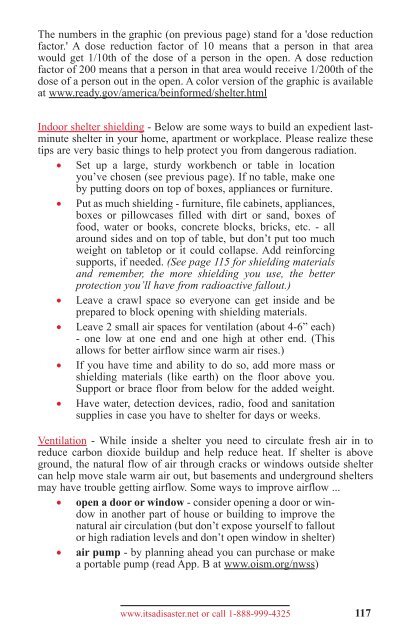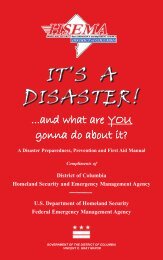disaster 5th 1108_5th ed 2011 - Homeland Security and Emergency ...
disaster 5th 1108_5th ed 2011 - Homeland Security and Emergency ...
disaster 5th 1108_5th ed 2011 - Homeland Security and Emergency ...
Create successful ePaper yourself
Turn your PDF publications into a flip-book with our unique Google optimized e-Paper software.
The numbers in the graphic (on previous page) st<strong>and</strong> for a 'dose r<strong>ed</strong>uction<br />
factor.' A dose r<strong>ed</strong>uction factor of 10 means that a person in that area<br />
would get 1/10th of the dose of a person in the open. A dose r<strong>ed</strong>uction<br />
factor of 200 means that a person in that area would receive 1/200th of the<br />
dose of a person out in the open. A color version of the graphic is available<br />
at www.ready.gov/america/beinform<strong>ed</strong>/shelter.html<br />
Indoor shelter shielding - Below are some ways to build an exp<strong>ed</strong>ient lastminute<br />
shelter in your home, apartment or workplace. Please realize these<br />
tips are very basic things to help protect you from dangerous radiation.<br />
• Set up a large, sturdy workbench or table in location<br />
you’ve chosen (see previous page). If no table, make one<br />
by putting doors on top of boxes, appliances or furniture.<br />
• Put as much shielding - furniture, file cabinets, appliances,<br />
boxes or pillowcases fill<strong>ed</strong> with dirt or s<strong>and</strong>, boxes of<br />
food, water or books, concrete blocks, bricks, etc. - all<br />
around sides <strong>and</strong> on top of table, but don’t put too much<br />
weight on tabletop or it could collapse. Add reinforcing<br />
supports, if ne<strong>ed</strong><strong>ed</strong>. (See page 115 for shielding materials<br />
<strong>and</strong> remember, the more shielding you use, the better<br />
protection you’ll have from radioactive fallout.)<br />
• Leave a crawl space so everyone can get inside <strong>and</strong> be<br />
prepar<strong>ed</strong> to block opening with shielding materials.<br />
• Leave 2 small air spaces for ventilation (about 4-6” each)<br />
- one low at one end <strong>and</strong> one high at other end. (This<br />
allows for better airflow since warm air rises.)<br />
• If you have time <strong>and</strong> ability to do so, add more mass or<br />
shielding materials (like earth) on the floor above you.<br />
Support or brace floor from below for the add<strong>ed</strong> weight.<br />
• Have water, detection devices, radio, food <strong>and</strong> sanitation<br />
supplies in case you have to shelter for days or weeks.<br />
Ventilation - While inside a shelter you ne<strong>ed</strong> to circulate fresh air in to<br />
r<strong>ed</strong>uce carbon dioxide buildup <strong>and</strong> help r<strong>ed</strong>uce heat. If shelter is above<br />
ground, the natural flow of air through cracks or windows outside shelter<br />
can help move stale warm air out, but basements <strong>and</strong> underground shelters<br />
may have trouble getting airflow. Some ways to improve airflow ...<br />
• open a door or window - consider opening a door or window<br />
in another part of house or building to improve the<br />
natural air circulation (but don’t expose yourself to fallout<br />
or high radiation levels <strong>and</strong> don’t open window in shelter)<br />
• air pump - by planning ahead you can purchase or make<br />
a portable pump (read App. B at www.oism.org/nwss)<br />
www.itsa<strong>disaster</strong>.net or call 1-888-999-4325<br />
117





